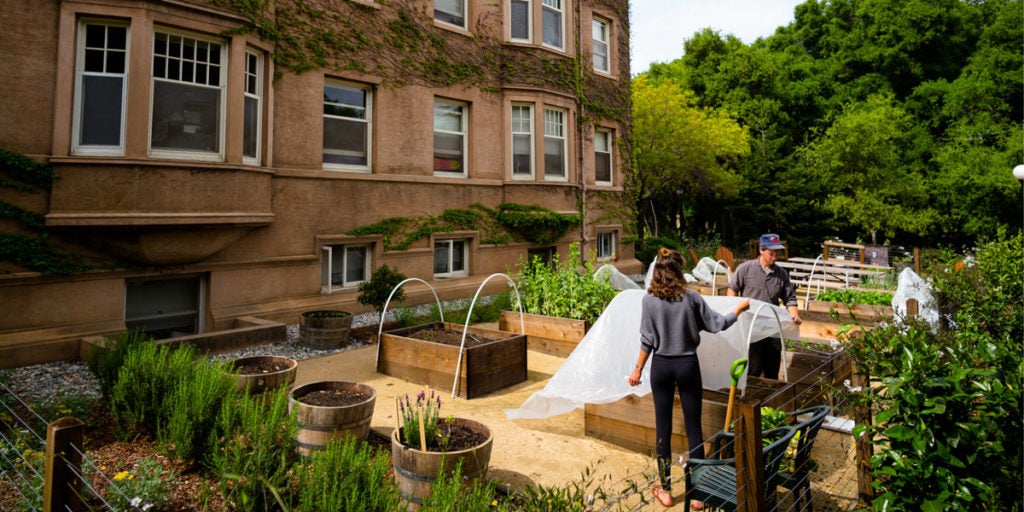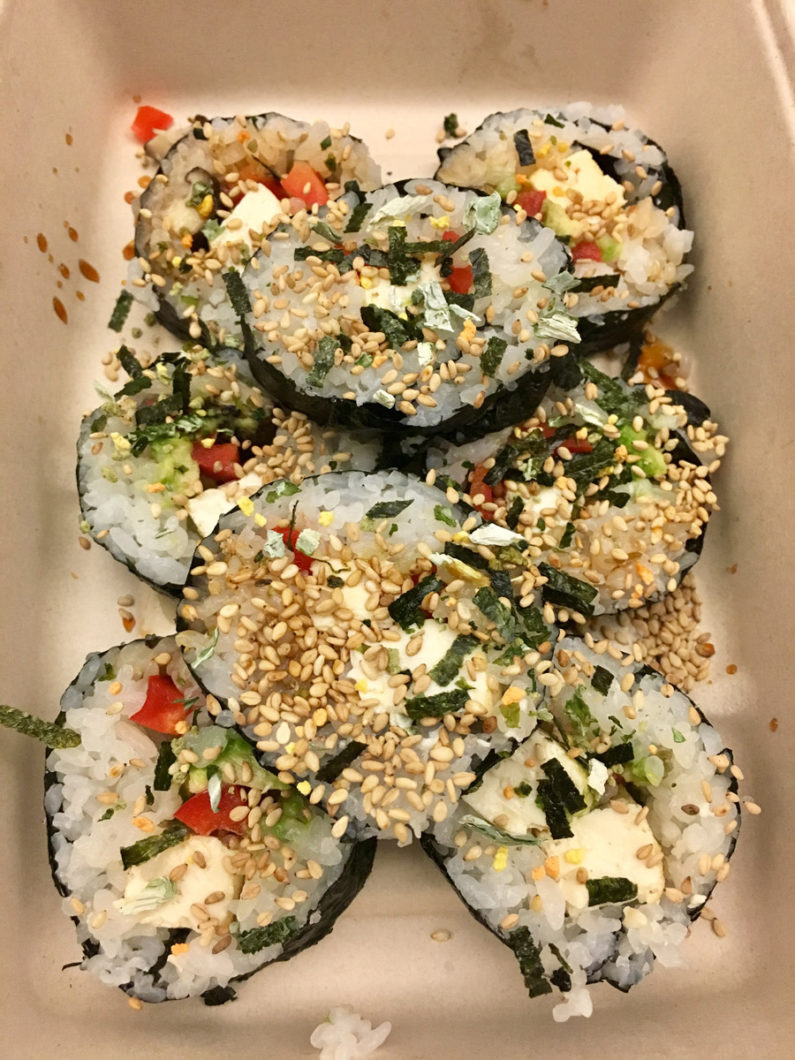Making Roble Hall sustainable for its second century

Photo: Aaron Kehoe/ Stanford University Communications.
Venerable, ivy-covered Roble Hall will turn 100 in 2018. Roble resident fellow Jeffrey Ball hopes that, in its second century, the dorm known as Stanford University’s “La Grande Dame” will stand as a symbol and embodiment of sustainable living.
Ball is a writer on energy and the environment, scholar-in-residence at Stanford’s Steyer-Taylor Center for Energy Policy and Finance, and a lecturer at Stanford Law School. In 2016, he organized and helped launch the Roble Living Laboratory for Sustainability at Stanford (ROLLSS). In the comprehensive and evolving program, students – through projects, classes, workshops and events – are attempting to make Stanford’s oldest continuously operating dorm a hub of sustainable learning and action.
“Roble is an iconic representation of the societal challenge of taking an existing structure and making it sustainable,” Ball said. “This place could be a platform to engage deeply in the complexity of these issues.”
Grassroots dorm movement
Part of what makes ROLLSS special is that, as a living laboratory, it seeks to integrate sustainability into everyday life. Most students who live in Roble haven’t pledged any particular commitment to sustainability. That’s important to ROLLSS, which aims to persuade people of all backgrounds and interests to wrestle with sustainability in ways that make them think.
“This is just an incredibly exciting initiative that takes one of the most pressing priorities of our age and invites students living in these dorms to grapple with it in a very immediate, direct, intimate way,” said James Campbell, professor of history and faculty director of Residential Programs who has been involved in several parts of ROLLSS.
Netta Wang, Sarah Dobbins and Spencer Guo make a salad from the organic greens grown in the Roble garden. (Image credit: Melissa Du)
As ROLLSS began to come together over the past year, interested Roble students formed a variety of sustainability-focused groups, including a ROLLSS student steering group which now has about 20 members. Two freshmen particularly active this year, Raja Ramesh and Kyle Enriquez, have taken it upon themselves to run initiatives encouraging students to conserve water by washing fuller loads of laundry and by taking shorter showers.
Next year will likely see additional participation, with added programs to bring in student leaders. One program will pre-assign 11 undergraduates to live in Roble as Sustainability Leaders. One of these leaders will live on each of the dorm’s 11 hallways. Together, they will help shape and implement ROLLSS through special projects, field trips, events and interactions with faculty and researchers – all centered on sustainability. Roble also is recruiting a doctoral candidate whose research focuses on sustainability to live in the dorm next year and help coordinate the ROLLSS program. (Applications for the Roble Sustainability Leader positions are open through April 13 and are available here; PhD students from any academic discipline may apply and may email roblelivinglaboratory@stanford.edu for more information.)
Sustainable dining
Earlier this academic year, students involved in ROLLSS founded the Roble Growing Club. The club helps maintain the Roble Hall Organic Teaching Garden, which was built last summer by (and is operated in partnership with) Stanford’s Residential and Dining Enterprises (R&DE).
“The organic teaching garden is one of my favorite parts of ROLLSS,” said Renee Cai, a sophomore who serves this year as an intern helping coordinate ROLLSS. “I remember it being just a patch of dirt when I was a freshman in Roble last year and now we’ve made meals with what we’ve grown.”
Though the garden was planted only last fall, the Roble Growing Club has already hosted dinners made from its yield with dishes including spring salad and roasted turnips. The events allowed the club to discuss sustainable-eating topics, such as eating seasonably, with an even broader group of Roble students.
Keeping the ROLLSS residential activities fun as well as informative is an important part of the program’s attempt to get people interested in a realistic way, Cai said. As part of her role as intern, she has hosted events including a vegan-sushi night where residents learned to make fish-free sushi and talked about what it’s like to eat a plant-based diet.
Even residents who are less regularly involved in ROLLSS are often influenced by its work. As part of its support for ROLLSS, R&DE installed two extra-low-flow mist showerheads in Roble bathrooms and outfitted all Roble student rooms with multi-stream recycling bins. Even Roble’s dorm-wide barbecues, held every other Friday evening in the dorm’s recently renovated rear courtyard, are going green. Students involved in ROLLSS are working to make this spring’s barbecues zero-waste events – avoiding single-serve condiment packages, using compostable plates and washable metal utensils, and ceasing to provide cups (students will bring their own reusable water bottles).
Courses and lectures
The program’s reach extends beyond students who live in Roble to courses and lectures that are open to the entire Stanford community. The Hard Earth speaker series, funded by the Vice Provost for Graduate Education, features talks every other Thursday evening by Stanford graduate students whose research focuses on sustainability challenges. The speakers represent a range of academic disciplines, including engineering, law and business.
Andrew Sonta, a graduate fellow in civil and environmental engineering, coordinates the Hard Earth series and facilitates an optional one-unit course. Registered students must attend all the talks and then discuss them in a seminar-style meeting on the alternate Thursday evenings when there are no presentations.
“Communication between the graduate and undergraduate communities should be emphasized because there is a lot to be shared,” Sonta said. “By having Stanford graduate students as our presenters, Hard Earth students gain the perspective of people with expert knowledge and experience but who are also their peers.”
This academic year, ROLLSS has also hosted two seminar classes taught in Roble and open to undergraduates across Stanford. One, which focused on sustainable food, was co-taught in the fall quarter by Matt Rothe, co-founder of Stanford’s FEED Collaborative, and Dara Silverstein, manager of R&DE’s sustainable food program. The other, a year-long series focused on assessing and trimming Roble’s environmental footprint, is taught by Michael Lepech, associate professor of civil and environmental engineering.
Students in Lepech’s fall-quarter class produced a lifecycle assessment of Roble that quantified the energy, water, waste and transportation impacts of residents and that, based on that assessment, recommended ways to make Roble more sustainable. The winter-quarter class evaluated each of those recommendations for its costs and benefits, ultimately recommending which potential interventions would produce the biggest environmental bang for the buck.
The laundry and shower projects, the no-waste barbecues and an effort to assess and minimize excessive lighting fixtures in Roble are all ideas informed by these classes.
Living in a living lab
Incorporating an academic program into residential life involves working through unique problems, such as envisioning how to create modern learning spaces within historic buildings or even navigating registration for residentially based courses. Campbell said tackling these issues has led to more effective communication and collaboration between administrative units across campus that are invested in this program.
“Ball and Lepech have created this extraordinary initiative that will not only enrich the 300-odd students who live in Roble every year but also provide a model throughout the Stanford community of how we can integrate students’ academic and residential lives in ways that enrich both,” he said.
Other challenges in the program have to do with the reality of implementing sustainable decisions in a historic building – a very real problem not just at Stanford but in many buildings and homes. One example: The initial plan was to install 10 of the mist showerheads in Roble, but the layout of the building’s bathrooms and piping accommodated only two. In addition, although Lepech’s class concluded that replacing Roble’s single-pane windows with more-efficient multi-pane ones could significantly reduce the dorm’s energy waste, the class discovered historic preservation rules are likely to make it difficult to upgrade to more efficient windows in buildings as historic as Roble. These are exactly the kinds of challenges Ball wants students to struggle with.
“ROLLSS is not about easy answers, it’s about hard questions,” he explained.
No Roble resident is forced to become a sustainability expert, but ROLLSS is offering every one of them, and members of the Stanford community, the opportunity to learn. In its diverse forms, from rigorous seminars to vegan-sushi workshops, ROLLSS is interweaving sustainability with life at Roble and seeing what that can do.
ROLLSS has drawn support and involvement from across Stanford, including the Precourt Institute for Energy; the Woods Institute for the Environment; the School of Earth, Energy & Environmental Sciences; the Office of Sustainability; the Office of Residential Education; the Office of Residential Programs; the offices of the vice provosts of undergraduate education, of graduate education, and of teaching and learning; the Department of Civil and Environmental Engineering; R&DE; the Stanford Energy Club, and Students for a Sustainable Stanford.


